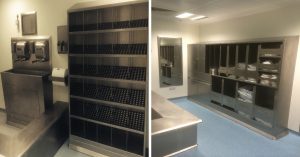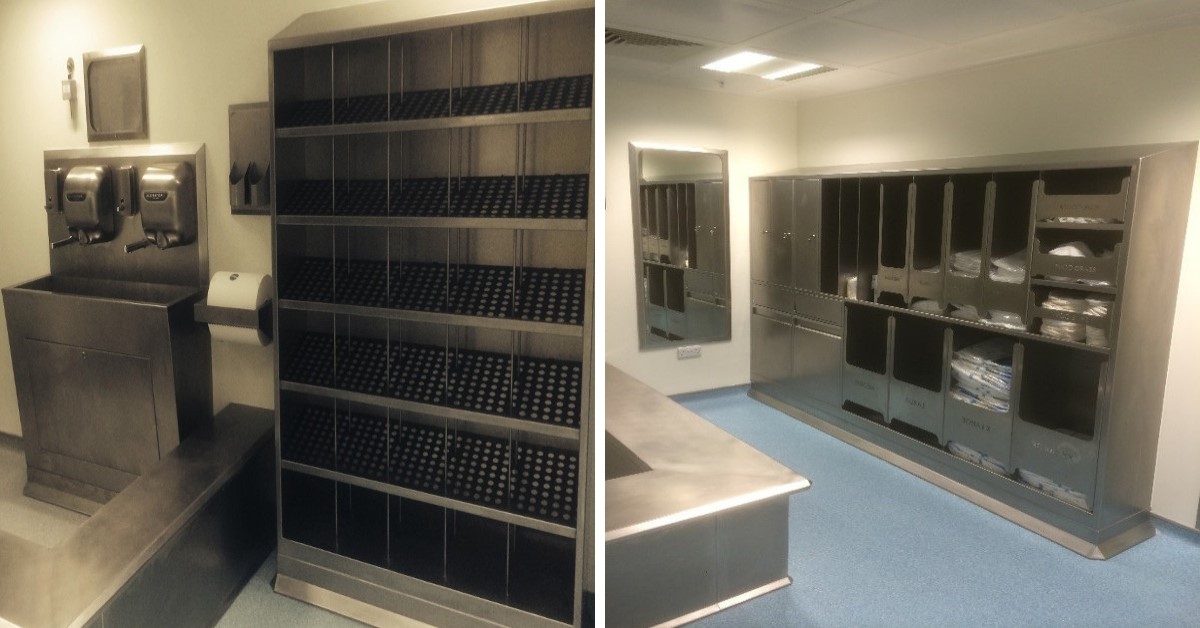
11 Furniture Design Tips for Cleanroom Gowning Areas
The design of the gowning area of your cleanroom is essential to ensuring the cleanroom itself doesn’t become contaminated. Your SOP (standard operating procedure) for gowning up should largely determine the layout of the gowning furnishings but you must also make the gowning room practical and ensure it has an ergonomic design. This will help workers use it efficiently and in accordance with GMP.
Be mindful as well that a well-designed and constructed gowning airlock will create a good first impression for both auditors and visitors. In addition, gowning areas should be easy to thoroughly clean.
The items of furniture in the gowning area of your cleanroom are essential components to achieving all these goals:
- Eliminate contamination
- Facilitate the gowning procedure
- Easy to clean
Here are 11 furniture design tips for cleanroom gowning areas.
1. Manufacture Furniture from Stainless Steel
Stainless steel is normally the material of choice when manufacturing furniture for cleanroom gowning areas. There are several reasons for this:
- Stainless steel is a highly adaptable material that can be used to manufacture a wide range of products
- Stainless steel is long-lasting
- Crucially for cleanroom environments, stainless steel is also easy to clean, not least because stainless steel cleanroom furniture can be manufactured with radiused edges. This eliminates hard to reach corners and crevices where particles can accumulate.
2. Select the Right Grade of Stainless Steel
You should carefully select the stainless-steel grade taking into consideration the cleaning materials your team will use. Bleach-based products are the most corrosive so, in these situations, we recommend grade 316 material. If you are using an alcohol-based product, however, grade 304 will be acceptable.
3. Properly Treat the Stainless-Steel Post-Fabrication
Stainless steel should be surface treated after it is fabricated as the passive layer of the stainless steel becomes compromised during the forming process. Without treatment, the stainless steel can, depending on the environment, rust and/or tarnish.
It is also important to ensure that stainless steel does not become contaminated during or after the fabrication process by other materials, particularly carbon steel. Choosing a manufacturer that exclusively fabricates stainless steel is also best practice.
Passivation is the most common treatment to restore the passive layer of stainless steel. Remember, though, that many stainless-steel fabricators will contract out passivation. In other words, they will ship the formed stainless steel to a third-party contractor to complete this work.
At Pharma Stainless, we believe this adds risk to the design and manufacturing process. Therefore, we complete all passivation of stainless steel in-house using our own modern equipment.
By taking this approach, we can control the entire manufacturing process, eliminate delays in treating the stainless steel, and ensure quality at every stage.
4. Pre-Gowning Area Design
In the pre-gowning area directly outside the cleanroom, you should provide lockers for staff so they can store personal items like their phones and items of jewellery.
Also, one of the single biggest causes of contamination in cleanrooms is hair. Therefore, we recommend you locate hair covers just outside the gowning room airlock door.
5. Illustrating Gowning procedures
In addition to having a written gowning procedure, it is also best practice to graphically illustrate your approved procedure next to a full-length mirror. This ensures correct gowning is adhered to by employees, contractors, and visitors
6. Optimise the Location of Shoe Cover Dispensers
The location of shoe cover dispensers should be determined by your gowning procedure. However, it is normal practice to locate the dispenser just outside the dirty line of the airlock. Usually, a barrier or crossover bench divides this line.
7. Optimise the Placement of Washing Stations
The washing facilities at the washing station should be non-touch. They should also be placed at the entrance to the gowning room so staff can wash their hands as soon as they enter.
Glove dispensers and/or glove liner dispensers should then be placed immediately beside the washing station.
8. Demarcate Pre-Gowning and Post-Gowning Areas
The overall design of the cleanroom gowning area and the placement of the furniture should ensure there is a clear demarcation between pre-gowning and post-gowning zones. This reduces the potential for non-gowned staff contaminating gowned staff.
9. Ensure Gowning Frames Facilitate Your Gowning Procedures
The design of storage units for gowning materials should facilitate your gowning procedure. For example, if your gowning procedures require staff to work from top to bottom, your gowning frame housing the protective clothing that staff will be putting on should make this process as simple and as easy to follow as possible.

10. Use the Right Bins
You might need bins beside the gowning procedure frame for workers to dispose of packaging, as well as in other areas of the cleanroom gowning area. Make sure the bins have foot pedals for opening to eliminate hand contact.
11. Ensure Gowning Benches Have an Ergonomic Design
Gowning benches for staff to sit on should be designed ergonomically to make it easy for workers to put on protective clothing. Hand rails can also be beneficial as they can help workers keep their balance while gowning.
Think of the Reverse Procedure
Finally, you should also consider the de-gowning procedure and take that into account when designing furniture for gowning rooms. There isn’t the same risk of decontamination with de-gowning, but it’s still important to make the de-gowning process as simple and efficient as possible.
Pharma Stainless provides cleanroom design and manufacturing services to the medical device and pharmaceuticals manufacturing industries. Find out more by visiting its website.
